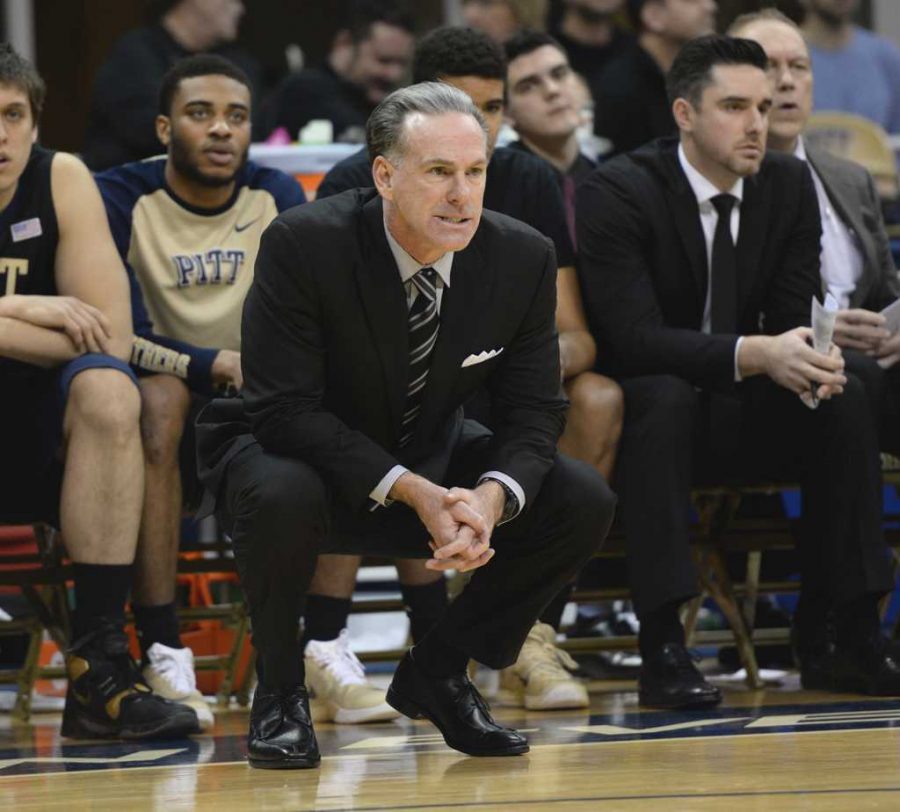After a 14-1 start to the season, the Pitt men’s basketball team seemed like a shoo-in selection for the NCAA Men’s Basketball Tournament.
That record came against a soft schedule, but the Panthers looked good, playing top-level offense with not completely inept defensive work. Ten games later, and the Panthers are 17-7, now fighting for their tournament lives in their final six regular season games.
The skid, based on the early returns is surprising.
Since the beginning of the season, Pitt proved to be an offensively-inclined squad rather than its typical defense-centric team. But given that physical deficiencies weren’t the root of the problem, it seemed fixable to an extent. Plus, and more importantly, Pitt looked good enough offensively to outscore opponents in most games.
Over a 2-5 stretch, capped by a three-game losing streak, Pitt has crushed any predisposed beliefs. Usually, teams improve over the course of the season. But Pitt has regressed.
The defense has been a sieve. Head coach Jamie Dixon has tried his typical man-to-man defense. He’s tried zone. He’s even tried some press. Nothing works for this team.
The Panthers aren’t lacking much in height or quickness on that end. Instead, the problems seem to be mental. For whatever reason, Pitt hasn’t grasped any sort of defense well enough to execute it for an extended period of time. Its help defense is bad. Its awareness is bad. The whole defense is just flat-out bad.
Even worse, the requisite effort doesn’t seem to be there. Effort is as important as anything to playing good defense, and when the team finds itself in ruts offensively, players get frustrated. Instead of trying to compensate defensively, the team lets that play seep into their offensive output.
This was as clear as ever against University of North Carolina, when Pitt allowed the Tar Heels to shoot 59.3 percent in a 21-point loss. North Carolina was clearly a class above Pitt in talent, but the team didn’t shoot almost 60 percent just because it was simply better. All game, quality shots were there, largely because of ineffectual defense.
Pitt’s poor offense might have also contributed to the defensive effort. North Carolina showed the blueprint necessary to stagger Pitt’s offense by extending defense and pressuring ball handlers.
When opponents get aggressive on that end, Pitt doesn’t have enough good ball handlers, and players attack the hoop to overcome that strategy. In college basketball, guards are key to thwarting most defenses. More specifically, guards that can penetrate the basket and get past their defender to create shots for themselves or teammates.
Pitt doesn’t have one player who fits that mold. At times, redshirt junior Chris Jones and freshman Damon Wilson can provide that, but neither are good enough decision makers or dribblers to do so consistently.
Pitt’s best guard is senior James Robinson, a smart player and good decision maker, but a player who’s limited athletically and is a largely inconsistent shooter.
Without the necessary guards, junior forwards Michael Young and Jamel Artis must force their hands. While both are talented offensively, neither possess the skill set to carry a team when opponents focus their attention on them with aggressive, pressuring defense.
To give Pitt credit, it can tear through menial defenses that are more relaxed and less assertive. But any smart coach with good enough players isn’t going to give Pitt that look defensively.
As it stands, Pitt is a bubble team, teetering on the edge of making or missing the tournament. Its road wins against University of Notre Dame and Florida State University as well as a win over Syracuse University look solid on its resumé. The Fighting Irish, Seminoles and Orange all have strong cases for tournament berths.
All three, though, are middle-to-lower-type seeds, certainly not statement wins. The Panthers will have a chance to earn one in the next six games, with back-to-back home games against the University of Louisville and Duke University.
Louisville is ranked No. 18 in the AP Top 25 Poll, so it would be the better win of the two, but Duke’s a good team whose name always carries weight, despite not being ranked for a significant portion of conference play. Just beating one of those two, plus winning three of their four games against Wake Forest University, Virginia Tech, Georgia Tech and Syracuse University would push the Panthers into the tournament.
It’s not a lofty task, as Wake Forest, Virginia Tech and Georgia Tech are all patently bad teams. And given Dixon’s history of making the tournament — 10 out of 12 times — there’s reason for hope.
Still, assuming anything outside of bad defensive play for this team is a fool’s errand. And though Dixon has earned the benefit of the doubt, he has missed the tournament two of the last four years.
Perhaps the Panthers will get it together these next six games, perhaps they won’t. Regardless, Pitt’s play is steeply trending down.
That much is unquestionably clear.


